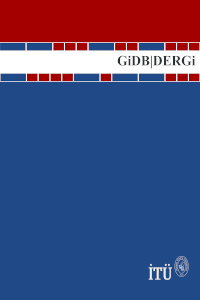ENVIROMENTAL RISK ASSESSMENT OF MARINE INVASIVE SPECIES CARRIED BY BALAST WATER
ENVIROMENTAL RISK ASSESSMENT OF MARINE INVASIVE SPECIES CARRIED BY BALAST WATER
Ballast water carried by ships is a significant vector to transfer of marine organisms beyond their natural ecoregions, resulting in economic, social and environmental negative impacts. The aim of this study is to investigate the risks of environmental negative impacts of marine invasive species by environmental risk assessment method and identify the high-risk invasive species, vessels and voyages for prioritization of inspections, compliance tests and monitoring activities. All marine species investigated for the risk assessment are chosen from Turkish coasts and the new method for risk classification is developed and specified for local risk assessments of marine invasive species carried by ballast water
Keywords:
Invasive species, Ballast water, risk assessment risk classification,
___
- IMO (2008). International Shipping and World Trade - Facts and figures. International Maritime Organization Maritime Knowledge Centre November (2008). 37pp
- Hulme, P. E. (2009). Trade, transport and trouble: managing invasive species pathways in an era of globalization. Journal of Applied Ecology, 46(1), 10-18.
- Tamelander, J. (2010). Guidelines for Development of a National Ballast Water Management Strategy–GloBallast Monograph Series No. 18. GEF-UNDP-IMO GloBallast Partnership and IUCN, London.
- Molnar, J. L., Gamboa, R. L., Revenga, C., & Spalding, M. D. (2008). Assessing the global threat of invasive species to marine biodiversity. Frontiers in Ecology and the Environment, 6(9), 485-492.
- Finenko, G. A., Abolmasova, G. I., Romanova, Z. A., Datsyk, N. A., & Anninskii, B. E. (2013). Population dynamics of the ctenophore Mnemiopsis leidyi and its impact on the zooplankton in the coastal regions of the Black Sea of the Crimean coast in 2004–2008. Oceanology, 53(1), 80-88.
- Swerdlow, D. L., Greene, K. D., Tauxe, R. V., Wells, J. G., Bean, N. H., Ries, A. A., ... & Tejada, E. (1992). Waterborne transmission of epidemic cholera in Trujillo, Peru: lessons for a continent at risk. The Lancet, 340(8810), 28-32.
- Bartoli, P., & Boudouresque, C. F. (1997). Caulerpa taxifolia. Marine Ecology Progress Series, 154, 253-260.
- Carlton JT. The scale and ecological consequences of biological invasions in the world’s oceans. In: Sandlund OT, Schei PJ, Viken A, editors. Invasive species and biodiversity management. Dordrecht: Kluwer Academic Publishers; 1999. p. 195–212.
- Thresher RE and Kuris AM. (2004). Options for managing invasive marine species. Biological Invasions 6: 295–300.
- Carlton JT and Ruiz GM. (2005). Vector science and integrated vector management in bioinvasion ecology: conceptual frameworks. In: Mooney HA, Mack RN, McNeely JA, et al. (Eds). Invasive alien species: a new synthesis. Washington, DC: Island Press.
- Byers, J. E., Reichard, S., Randall, J. M., Parker, I. M., Smith, C. S., Lonsdale, W. M., & Hayes, D. (2002). Directing research to reduce the impacts of nonindigenous species. Conservation Biology, 16(3), 630-640.
- Cal-IPC (California Invasive Plant Council). 2003. Criteria for categorizing invasive non- native plants that threaten wildlands. www.cal-ipc.org/ip/inventory/pdf/Criteria.pdf. Viewed 1 Dec 2015.
- Salafsky, N., Salzer, D., Ervin, J., Boucher, T., & Ostlie, W. (2003). Conventions for defining, naming, measuring, combining, and mapping threats in conservation. An initial proposal for a standard system. Draft version.
- NatureServe. 2004. An invasive species assessment protocol: evaluating non-native plants for their impact on biodiversity. www.natureserve.org/library/invasiveSpeciesAssessment Protocol.pdf. Viewed 15 Nov 2015.
- Republic of Turkey Ministry of Transport, Maritime Affairs and Communications, (2010). Ballast Water Management Status Assessment Report for Turkey. Ankara, pp.33-37.
- Heil, C. A., Glibert, P. M., & Fan, C. (2005). Prorocentrum minimum (Pavillard) Schiller: A review of a harmful algal bloom species of growing worldwide importance. Harmful Algae, 4(3), 449-470.
- Mann, R., Occhipinti, A., & Harding, J. M. (Eds.). (2004). Alien species alert: Rapana venosa (veined whelk) (p. 14). International Council for the Exploration of the Sea.
- Nehring, S. (2012). Invasive Alien Species Fact Sheet–Callinectes sapidus.
- Ward, R. D., & Andrew, J. (1995). Population genetics of the northern Pacific seastar Asterias amurensis (Echinodermata: Asteriidae): allozyme differentiation among Japanese, Russian, and recently introduced Tasmanian populations. Marine Biology, 124(1), 99-109.
- Finenko, G. A., Romanova, Z. A., Abolmasova, G. I., Anninsky, B. E., Svetlichny, L. S., Hubareva, E. S., & Kideys, A. E. (2003). Population dynamics, ingestion, growth and reproduction rates of the invader Beroe ovata and its impact on plankton community in Sevastopol Bay, the Black Sea. Journal of Plankton Research, 25(5), 539-549.
- Ward, R. D., & Andrew, J. (1995). Population genetics of the northern Pacific seastar Asterias amurensis (Echinodermata: Asteriidae): allozyme differentiation among Japanese, Russian, and recently introduced Tasmanian populations. Marine Biology, 124(1), 99-109.
- Boero, F., Putti, M., Trainito, E., Prontera, E., Piraino, S., & Shiganova, T. A. (2009). First records of Mnemiopsis leidyi (Ctenophora) from the Ligurian, Thyrrhenian and Ionian Seas (Western Mediterranean) and first record of Phyllorhiza punctata (Cnidaria) from the Western Mediterranean. Aquatic Invasions, 4(4), 675-680.
- Dawes, C. J., & Mathieson, A. C. (2008). The seaweeds of Florida. University Press of Florida.
- Başlangıç: 2015
- Yayıncı: İstanbul Teknik Üniversitesi
Sayıdaki Diğer Makaleler
INDUSTRY BASED SHIP DESIGN PROJECT FOR NAVAL ARCHITECTURE STUDENTS
ENVIROMENTAL RISK ASSESSMENT OF MARINE INVASIVE SPECIES CARRIED BY BALAST WATER
RISK ANALYSIS OF INTERNAL COMBUSTION ENGINE VALVE PRODUCTION USING FMEA METHOD
FAULT TOLERANT CONTROL OF THE ELECTRIC PROPULSION FOR AUTONOMOUS SURFACE VEHICLES
